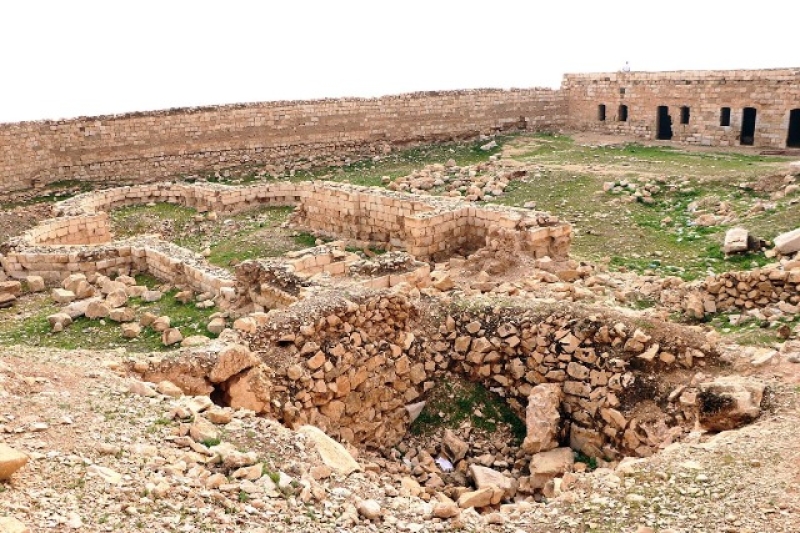- US Issues Travel Alert for Bangladesh Ahead of Election |
- Air ambulance carrying bullet-hit Hadi flies for Singapore |
- Can Dhaka’s arms recovery drive ensure peaceful polls? |
- ‘Unhealthy’ air quality recorded in Dhaka Monday morning |
- BD peacekeepers' deaths: UN chief calls Dr. Yunus, offers condolence |
OIC Monitors Israel's Ambitions for Jericho's Antiquities

Archaeological areas in the Jericho and Jordan Valley Governorate. OIC News
Jeddah, 13 January, 2025 - The Organization of Islamic Cooperation's Media Observatory for Israel's Crimes against Palestinians has noted an increase in settler incursions into archaeological sites in a number of areas in the West Bank, especially in the last week of December 2024. During this period, settlers performed Talmudic rituals coinciding with what is known as the "Festival of Lights" in the archaeological areas in the Jericho and Jordan Valley Governorate, which ranks second among the Palestinian governorates that are subject to Israeli control and seizure of their lands after occupied al-Quds.
On December 26, 2024, settlers entered the Herod's Palace area in Jericho and set fire to the archaeological site near the palace, under the pretext of performing "Talmudic" rituals. The following day 27th of December 2024, other settlers entered the Tel Ma'in archaeological site east of the town of Yatta in Hebron, and installed a "candelabra" and performed their "Talmudic" rituals, while others installed a "Hanukkah candle" or "candelabrum" on the Diokos (Al-Hawtah) archaeological fortress at the top of Mount Qarantul in Jericho. On August 14, 2024, the Israeli occupation authorities intensified their raids on the Al-Masoudiya archaeological area near Nablus.
Most recently, on January 10, 2025, the Israeli occupation forces prevented Palestinian farmers from plowing their lands in the Umm al-Quba plain in the northern Jordan Valley, as part of the occupation's plans to control those areas and impose an economic siege on the Palestinians.
In a report by the Palestinian Ministry of Tourism and Antiquities, which was provided specifically to the OIC Media Observatory, Israel, the occupying power, has begun to employ antiquities in the Palestinian territories to claim ownership of the land in the West Bank and expand the construction of its settlements there, while its projects and plans to control antiquities in the West Bank can be added to its efforts to annex it.
According to the ministry’s report, the Israeli effort to control Palestinian antiquities dates back to 1967, and Israeli excavations focused on the Abu al-Alaiq hills in Jericho, the “Herod’s Winter Palaces” and Tel al-Furaidis east of Bethlehem, and the Qumran ruins, Khan al-Ahmar, and Mount Gerizim in Nablus.
A legislative proposal by Likud Knesset member Amit Halevi, called for amendments to the Israeli Antiquities Authority Law under the title “Amendment to the Israeli Antiquities Authority in Judea and Samaria 2023”. The proposed amendment seek to apply Israeli antiquities laws to the West Bank so that they become the responsibility of the Israeli Antiquities Authority. On July 7, 2024, a ministerial committee in the Israeli government approved Halevi's proposals, and the decision was later transformed into a military order to seize Palestinian archaeological sites in the town of Sebastia. The decision was made under the pretext that "the alleged Jewish antiquities in the West Bank are being vandalized by the Palestinians”.
The Palestinian Ministry of Foreign Affairs and Expatriates had warned on July 15, 2023, about an Israeli plan to control Palestinian archaeological sites, and called on the United Nations Educational, Scientific and Cultural Organization (UNESCO) to assume its responsibilities towards this. Palestinian archaeological sites are usually seized by Zionist settlement organizations, which consequently prevent Palestinians from entering those sites.
It is worth noting that Jericho, the southern Jordan Valley, eastern Tubas in the northern Jordan Valley, and the Dead Sea area are among the historical areas targeted by Israel.
Israeli control over archaeological areas has extended to religious demands, as the Israeli occupation seeks to include religious sites on Palestinian lands in the Jewish heritage, while they are included under the Israeli nature protection authority under the pretext of protecting nature, or placing military watchtowers, as was done in the case of the shrine of the Prophet Yaqeen in Bani Naim.
On the other hand, the settlement project in Jericho is different from other settlement projects in the rest of the Palestinian areas due to its economic, agricultural and touristic importance, and because it is relatively far from the separation wall and its strategic location on the border with Jordan, which makes it a strategic security target such that it is made an eastern buffer zone. Israel also views the historical dimension of Jericho as important, which explains its frantic pursuit of controlling the archaeological areas there.
Observers believe that Israel is targeting Jericho due to the low Palestinian population density in the city, which makes it an easy target for Israel, while 53,000 Palestinians live in 12 communities in various areas of Jericho. In contrast, there are 16 major Israeli settlements and five settlement outposts in the Palestinian governorate, inhabited by 8,500 settlers. – OIC News

